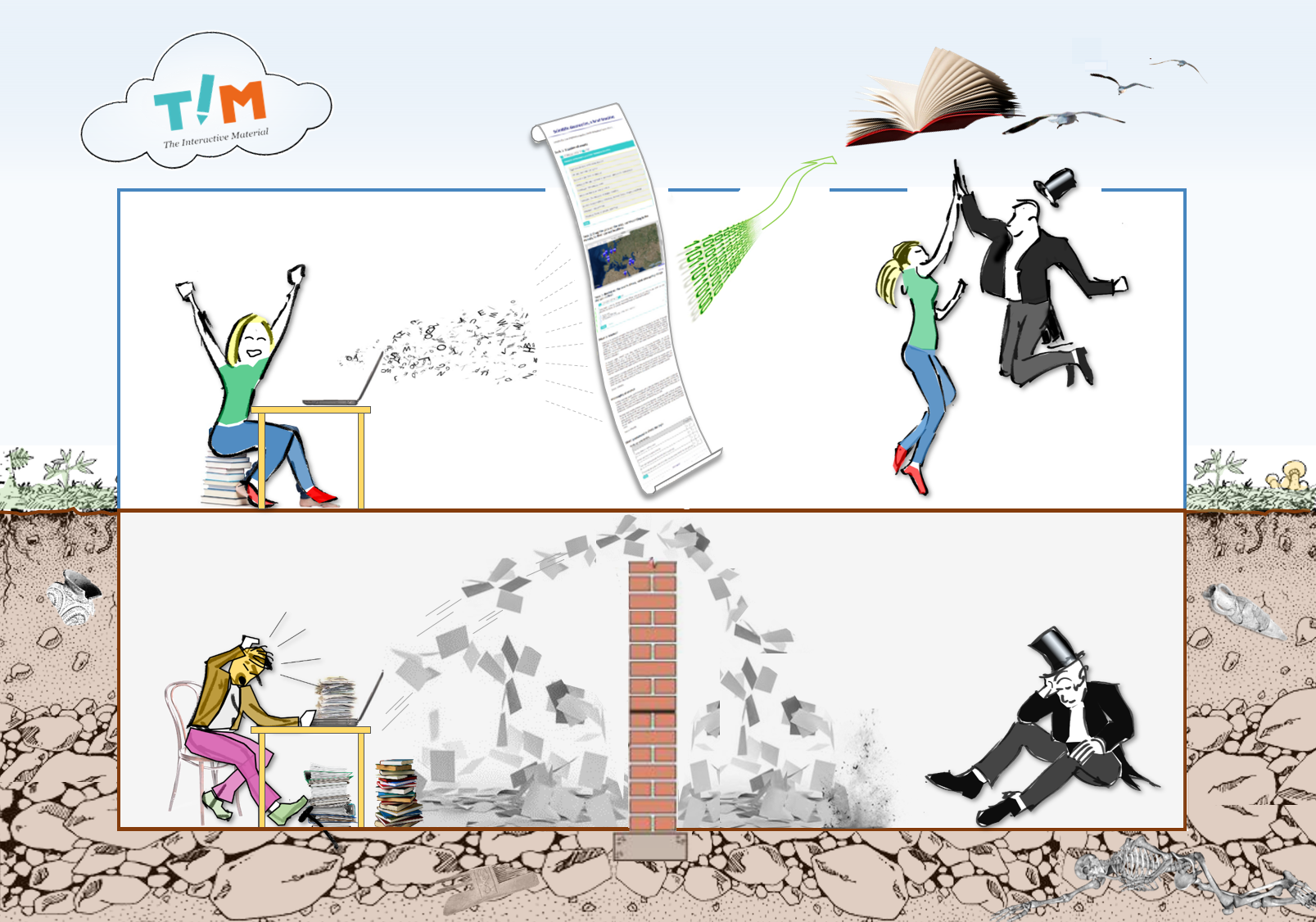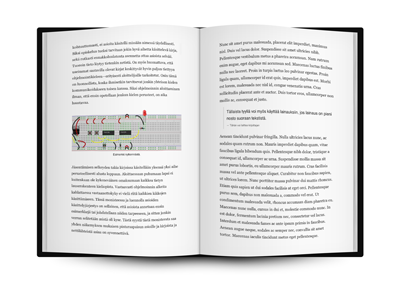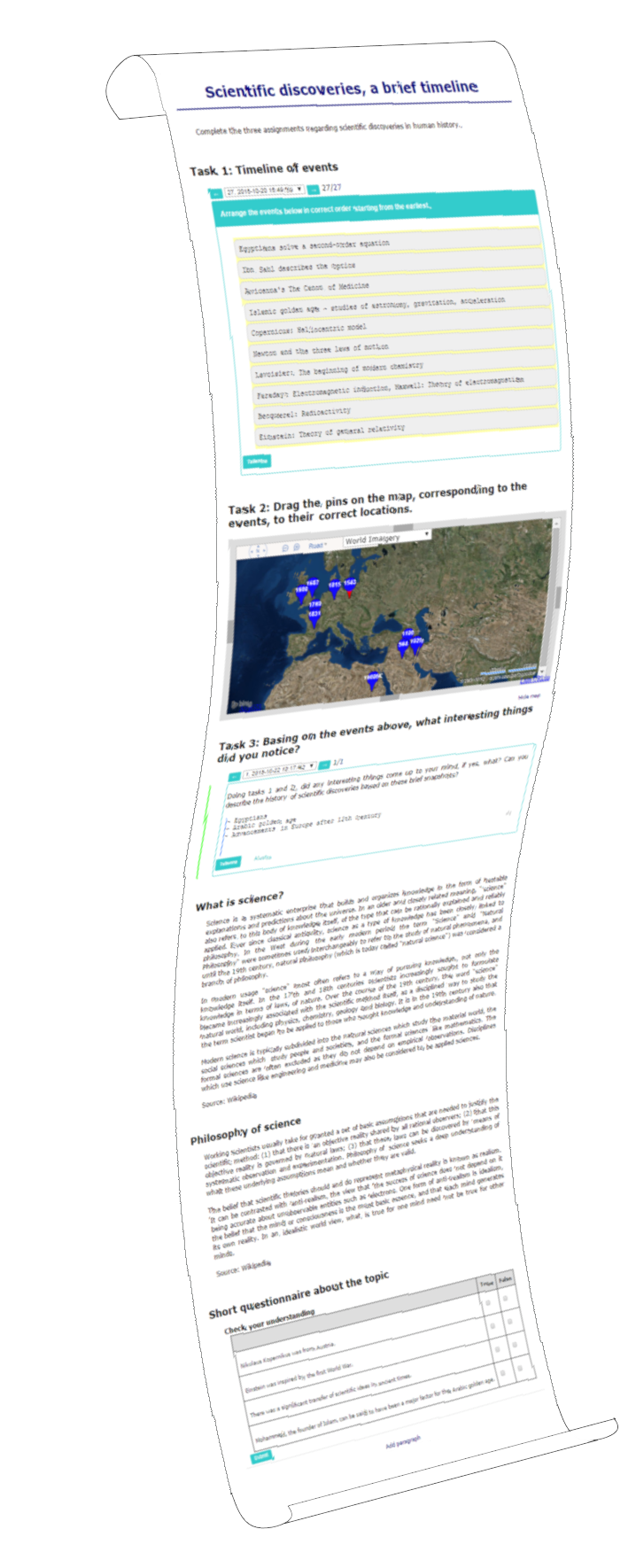Introduction to TIM
What is TIM?

Mission
- To have the best general purpose digital learning environment (LMS) in the world.
- Material that can be read and produced anywhere, any time, with any device.
Dream
- Teachers and students writing open learning materials that fluently combine theory and interaction together.
What is TIM ... continue
Goal: The Incredible Material
TIM is a document-based cloud service for producing interactive materials.
Building blocks of TIM:
- document
- block
- a block can be a block of text, e.g. one or more paragraphs, or
- an interactive component, plugin
These can be used to built any type of learning material, from a single presentation slide to an entire textbook.
Project TIM
- The name of the project is TIM (The Interactive Material)
- tim@jyu.fi
- Open source (MIT-licence)
- Faculty of Information Technology, University of Jyväskylä
- Vesa Lappalainen (vesal@jyu.fi) and Ville Tirronen (aleator@jyu.fi)
- Software developers Mika Lehtinen and a large group of other developers
- layout Seppo Tarvainen
- over 22000 documents
- circa 9000 users
Introduction pages
This page will not introduce TIM's interactive components individually. For more information, see the following page:
Other links:
- PedaForum17 material: TIM - "less is more"
- TIM instructions
- comparing learning environments
Video introductions to TIM:
The basic idea of TIM
Current materials have turned into terrible mess of links where the main flow is hard to follow. The goal of TIM is to bring back textbook-style organisation. The kind where once you have gone through the material, you have formed a general idea of the topic. TIM adds immediate interaction to the textbook. The layout of TIM actually resembles a papyrus roll, because there is no pagination.


TIM is suitable for self-study, MOOCs, traditional lecture course learning, Flipped Classroom, Peer Instruction and other forms of study.
Even though all the examples below are related to teaching programming, TIM is in no way connected to just programming: TIM can be used for anything, for example primary school geography classes. A distant dream would be that school textbooks were replaced with TIM materials.
TIM has also very large possibilities to follow partial course performance. This part can be used even no other TIM feature is used.

Examples of the possibilities of TIM
To get acquainted with TIM, start by logging in by clicking the Log in button at the top of the screen. Login via either Korppi or create a new account (Sign up).
After login you can try, either in this document or any other document in TIM:
- add your own notes by clicking this paragraph once and selecting "C" from menu on the right
- clicking paragraphs as read by clicking the red bar on the right side
- changing the appearence of TIM from the Customize TIM link which is behind the cog icon at the top left corner (in the future, this can be done within the document)
Further, you can also check out a few complete TIM materials:
- Programming 1/C#: Lecture notes (FIN), demo practice (FIN), demos (FIN), Lecture notes in English, PDF
- Programming 2/Java: Lecture notes, demot
- Tietokannat (Databases) course Lecture notes
For example, in the Programming 1 materials you can try
- watch videos
- try exercises
- the student-made lecture video index
The following document contains a set of possibilities that TIM offers at the moment
Other materials available/coming up in TIM:
- Z boson lab for Physics: FYSA2002: Hiukkasfysiikan data-analyysi aidolla CERNin tutkimusdatalla
- TIM is one of the platforms in the 2016 eEducation project
- Upper secondary school students' IT competetition
- Programming 1 exam
- Introduction to Information Technology
- ITKP104 Tietoverkot, Demo 1
- several other IT courses (also non-programming-related)
- Timppa project documents
- Databases course
- Java and databases course
- R course for Statistics
- Calculus 1
- Calculus 2
- Calculus 3
- Series and Integrals course for Mathematics
- Discrete mathematics course
- Buffer Solutions (Chemistry)
- Master's theses, see e.g.: Ohjelmistorobotiikka
- Physical education laboratory "work exam"
- University guide to quality
- Agendas and minutes for the meetings of the Faculty of IT (the agenda is turned into minutes with the press of a button).
Students' opinions about TIM
(translated from Finnish)
- TIM lecture notes are excellent.
- TIM has been neatly written. Topics are clearly presented. The best "lecture notes" ever.
- TIM web materials are excellent
- TIM is magnificent
- The renewed lecture notes (TIM) are great!
- Tim is good. I cannot come up with improvement suggestions.
- TIM lecture notes are an excellent tool for the course.
- TIM makes full and varied use of the fact that it is electronic learning material. Most often electrical learning materials function almost exactly like the paper versions, the only differences are that where answers are clicked instead of written, the wrong answer receives immediate feedback, or you don't have to turn pages... But very few materials have actually utilized the possibilities of electrical online materials or e.g. real-time features. Genuinely interactive learning material like TIM should be used on each study level (the only real problem would be that the teachers would need to update it by themselves). A business idea for some enterprise... Perhaps students do not realize (as I don't myself) how pedagogically brilliant materials they are using, but it most probably makes learning and understanding a lot easier.
- TIM system is fantastic, it may well be the biggest reason why I experience learning how to program as an easy task.
- TIM- system is really nice.
- TIM worked great, the online material enabled flexible scheduling.
- I have been using TIM with a Windows laptop, an iPad, an Android tablet, a phone and an iPhone with great success. TIM is one of the most interactive learning environments I have used and I take my hat off to its versatility.
Teachers' opinions about TIM
- TIM is the first online platform I have encountered that can genuinely be used to serve pedagogy. For example, if I use Moodle, I usually have to start with "what can Moodle do", whereas with TIM I can start with "What I want to be done".
- From the teacher's perspective, the TIM platform provides tools for all the basic needs for teaching. The teacher can write all the texts needed in teaching and link them on TIM, make exercises, and make revision and feedback tools related to teaching so that students can communicate their views with the teacher anonymously. TIM also enables revising and giving points for exercises and it can be used to follow the student's course progress. From the student's perspective, TIM contains all the content for the course and information related to passing the course in one place. TIM is especially useful for teaching information technology and mathematical subjects. It offers tools for limiting and presenting material so that the attention of the students is focused on central details. Other so-called learning environments do not offer similar tools. Also colleagues from other universities have spontaneously stated in private conversations that the TIM platform designed in the University of Jyväskylä is quite unique.
- The best feature in TIM for a teacher is the freedom to create versatile exercises and revision tools that automatically grade the exercises and give feedback to the student. The student can see their success immediately and use the feedback to improve their answers. The teacher can limit the number of times that the student can try to answer, define the grading scale and what kind of feedback is given
- Xx and I were discussing why TIM is such a great tool for us. I have called it (e.g. in the JYU newsletter) the Harry Potter lecture material, where images live (videos, simulations, and why not web links and extra stuff for those interested). It is a great feature that students can check their understanding (I need to add more of this for my courses). We have also received commendable feedback for these features.
Why TIM?
- possibility to produce book-like, linearly proceeding material
- documents can be given read/edit rights in a flexible way
- everyone can adjust the appearence of documents according to their tastes
- accessibility (improvements coming)
- for quality prints: automatic conversion to TeX and further to PDF (=online version and print version from one material). See PDF version of Programming 1 lecture notes
- "why not Wiki" etc.? Long texts are arduous to edit with e.g. Track-Wiki
- "Why not Google Docs or Office 365"? Google Docs is not compatible with realistically sized lecture notes. These tools also lack a lot of features that are already in TIM or will be added to TIM.
- TIM works on PCs, tablets, and phones regardless of brand/manufacturer
- easy to tailor without covering the basic structure
- wiki-like editing, meaning that anyone with the right to edit can edit the document. Teacher can decide to give the right to some/all course
attendees. Or the teacher/editor of the material can keep the right to themselves, while students are allowed to suggest corrections that the editor can then either accept or reject. Even if the students make changes to the material, complete document version history is available, allowing to view who has changed what and revert the changes if necessary.
- translation from one language to another: a new copy of the document is made, which is (manually) translated so that if the original changes, there will be a note about the specific translation being out of date, making different language version maintenance easier.
- citing parts of documents: parts from other documents can be cited or a version of the document can be made where topics are presented in some different order or in short. Again, if the main document is changed, the cited parts will change as well.
- modularity: e.g. executing programming course programs without installing the programs locally is a TIM plugin, and similar plugins can be made for the needs of other fields as well. Programming languages that are currently in use include e.g. C#, Java, C, C++, Python 3, Common Lisp, F#, Scala, Kotlin, JavaScript, Swift, Processing, GlowScript, WeScheme, SQL, PSQL, R, Sage, Rust, Pascal, Fortran, and Swift. In addition, you can run shell commands and databases in TIM. Furthermore, there are ready-made plugins for e.g. multiple-choice questions, drag&drop, arranging exercises as well as drawing e.g. plugins which can be used to create more exercises within the material. It is of course also possible to provide a simple textbox for answers. Also exercises from other systems/platforms can be embedded in TIM almost without bounds. Teachers can browse through the student answers and grade them if the plugins do not offer automatic grading.
- TIM also contains an integrated InSitu/Clicker type plugin (cf. Peer Instruction) for improving the interactivity of lectures (so that the teacher doesn't necessarily need other tools than TIM, making the threshold for using TIM lower).
- lecture board (i.e. real-time chat)
- lecture slides from the same material. Synchronisation of the student's slides to the teacher's slides (so that the students don't need to ask where we're at). The idea is that part of the texts in the material would be linked to the slides so that they can be maintained from one place. Currently, if there is an error somewhere, it needs to be corrected from both the material and the slides.
- student notes: In the future, notes can be written on different levels of publicity, for example personal, visible to teachers, or visible to other students. The goal is that the teacher can easily browse through the comments related to a paragraph and also student answers to exercises and possibly grade them as well. In part, the exercises can of course have automatic grading.
- Velps = Virtual Help notes, correction phrases: possibility to create a collection of phrases that the teacher can include/move to the student answer while grading exercises or exams.
- "I have read/understood" buttons when necessary, making it possible to study if leaving a part of the material unread affects understanding. Usually there is no reliable way to know if the students read the materials or not. In the future, clicking "I have understood" could have the function that some exercise related to the topic is randomly selected and presented to the student. This might not necessarily happen every time but every once in a while. If the student answer to the exercise is wrong, they might lose some of their earlier "I have understood" markings (or something else similar). The students can see where they have already been if they do not follow the lecture notes in order. The students can also see if paragraphs have changed since they marked them as read (materials change constantly, when new text is added or some errors are corrected). This feature could also be useful when making different preparatory materials. This saves time because you don't have to read through the materials, only to receive a new version of 20 pages where you aren't sure what changed.
- It is possible to keep an automatic record of which parts of the material the student has already studied. This allows to study if the automatic record is sufficient or if the students needs to be "forced" to click something. Teachers receive information about what the students have already studied.
- kalenteri - resurssien ja ajan varaaminen, ilmoittautuminen
postilistat ja niiden arkistot
TIM-viestit
- group answers
- gamified summaries of results
- document history of what has changed since the reader last read the document
- when necessary, email notifications about new comments on the document
- when necessary, email notifications about changes on the document
- when necessary, live documents, i.e. if someone else makes changes, the changes are visible live without having to the refresh the page
mathematical notation with TeX
different types of embedded exercises:
- programming languages
- different math exercises
- MathCheck, GeoGebra, Sage, Maxima, Octave, Stack
- multiple choice
- image upload for e.g. handwritten answers
- drawing exercises,
- drag & drop exercises etc.
- feedback
- text answers
- simulation of digital logic circuits (and automatic revision)
randomized exercises and parts of documents
multiple exercise types can be graded automatically
scheduled document visibility by person and by group
if necessary, scheduled visibility of individual exercises
entrance exams where the applicant knows their result immediately after the exam have been held in TIM
exams have been held in TIM
visibility of parts of document by person and by group, i.e. different groups can view different content => enables e.g. studying how different materials affect learning
- Q/A
- chat
- forum
- writing your own documents (e.g. CV, portfolio, longer texts such as essays, bachelor's and master's theses)
- is well-suited for e.g.
- writing documents
- maintaining multilanguage documents thanks to linking
- writing preparatory acts
- own notes
- TODO lists
- Plugins for teaching languages with dynamic turn in. Can also be used for other things.
- Complete tracking of course progress (fi) and forwarding results to other systems, allowing the use of TIM as a course bookkeeping system.
Q & A
Question: Is TIM only suited for teaching Information Technology?
Answer: Certainly not! Most of the ready-made materials are related to IT, but sky's the limit. TIM is as suited for making an alphabet-book for first graders as it is for making a psychology "textbook".Question: I have my old material in Word, can I convert it into TIM?
Answer: soon, so that the .docx file can just be uploaded to TIM. Same with TeX material.
Contact me if you want to participate in development or try tim@jyu.fi.
Vesa